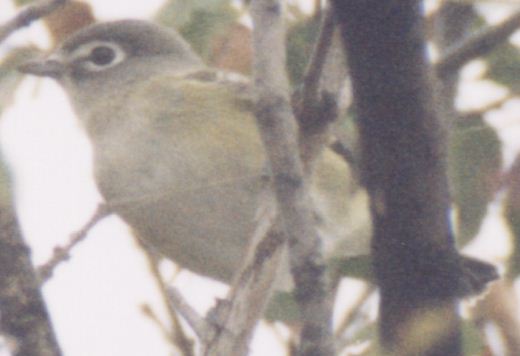Update: I've added a few coments,
plus links to photos/discussion of CAVIs at the bottom of the
page:
These photos of a Solitary Vireo showing characteristics of Cassin's Vireo (Vireo cassinii)
were taken by Martin Reid at Mosque Point, Lake Worth, Tarrant
County, Texas on October 07, 2002. NOTE that the sky was fully
clouded with the sun behind/left of the bird in these photos (taken
with a telephoto lens, thus not subject to the paling I
get when shooting through a telescope), this is causing the forecrown
to look darker than in real life (it looked fairly uniform in
the field, and the rear was quite olive in tone, blending into
the mantle); note also the rather thin bill (how unusal is this?),
and the thin, diffuse band of dusky-olive separating the off-white
throat from the chest:




A fall
bird from "lowland" Colorado, with discussion by
Tony Leukering: Tony introduced this bird to ID-FRONTIERS
in Spring 2002, and said, in part: "Here in Colorado,
we get all three species, with BHVI being a vagrant (and it's
on the review list). As I've posted to this format a couple times,
CAVI is much more common than even the Colorado-breeding PLVI
in fall out on the plains." - the underlined emphasis
is mine, not Tony's.
A late
summer bird from Nebraska: This is the only image of a
CAVI that is somewhat backlit - all the above photos are clearly
backlit - note how the crown looks shaded darker in this lighting,
as it does in the above images (in real life the crown was a pale
gray with greenish tones.)
A female
on the nest in the Sierra Nevadas:
A bird
from California:
A bird
from Coastal British Columbia:
A late
summer bird from Nebraska:
A selection
of birds from California:
An unknown
locality and date:
When you add to this mix the number of reports of CAVI from
the Lubbock area in Fall, I wonder if we have a chicken-and-egg
situation here: perhaps the "dull BHVIs" seen in the
central third of Texas in September and early October are actually
CAVIs? if so, then CAVIs are far more likely to drift eastwards
into North-central Texas than current knowledge suggests (there
is no formally accepted Texas record of CAVI east of the Pecos,
I believe - although there are birds videod in Corpus Christie
from Fall/Winter that seem likely to provide such documentation.)




